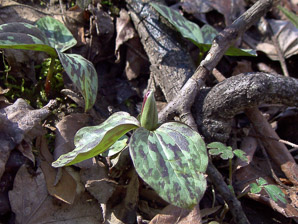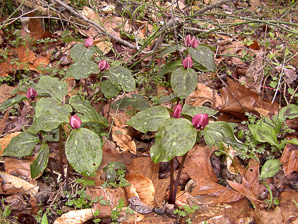
|
Trillium sessile L. Toadshade trillium, sessile trillium, toad trillium, sessile-flowered wake-robin
Sessile trillium, so named because its flower is nestled next to the leaves, rather than elevated above it, is native to part of eastern North America. Alternate names, such as toadshade trillium, refer to the mottled appearance of the leaves, though leaves are not always mottled. This species prefers moist, rich limestone soils, and floodplains. Plants: Plants are 5-12″ (12-30 cm) tall, comprised of a single stalk topped by three leaves, with a single, stalkless flower in the center. Leaves: Three bracts (modified leaves) are arranged in a whorl around the top of the stalk. Each leaf is oval to nearly circuilar, with blunt tips, and up to 4″ (10 cm) long and 3″ (8 cm) across. Sometimes they have a mottled appearance, a patchwork of varying shades of green, bluish-green, or brownish. Flowers: Each stalk is topped by a single flower, with three maroon or brownish petals (sometimes green or yellowish-green). Petals are up to 1¼″ (3.5 cm) long and ¾″ (2 cm) wide. The flowers are attached directly to the stalk (sessile), rather than elevated above it. There are three green sepals between the petals, sometimes streaked with maroon. Often the flowers remain closed, though the sepals are open. The flowers are described as foul-smelling, with an odor resembling that of rotting meat. (Most trilliums are odorless, with the exception of this and Trillium foetidissimum.) They appear from May to June. Fruits: A whitish to dark greenish-purple, three-celled, six-sided berry. Edibility: Although small amounts of young leaves are sometimes used sparingly to flavor salads and soups, plants, and especially the fruits, can induce vomiting. Online References:
The U.S. Forest Service Celebrating Wildflowers site
Trillium sessile description by Thomas H. Kent, last updated 20 Dec 2020. © FloraFinder.org. All rights reserved. |
This could also be Trillium cuneatum, which is larger but otherwise identical. · 3/5/2000 · Memphis, Tennessee · By Tim Chandler This could also be Trillium cuneatum, which is larger but otherwise identical. · 3/19/2000 · Memphis, Tennessee · By Tim Chandler Range:
|




